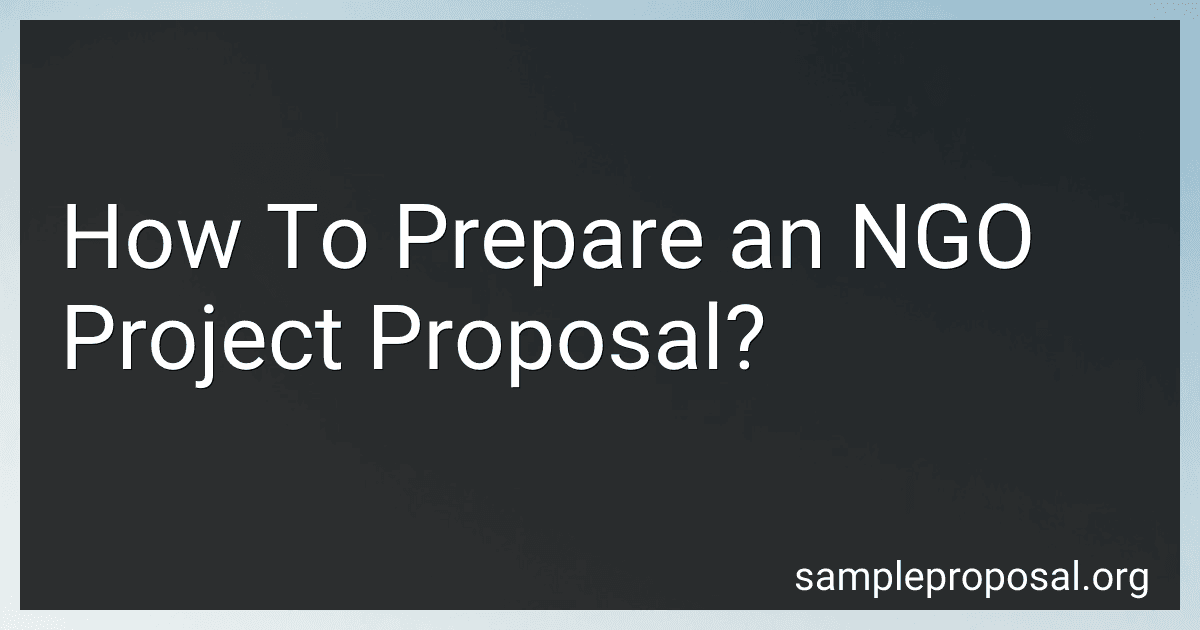Best Resources to Buy for NGO Project Preparation in January 2026
Preparing an NGO project proposal involves several key components. Start with a clear and concise executive summary, which provides an overview of the project, including the problem statement, objectives, and the proposed solution. This sets the stage for the reader to understand the context and importance of the project. Next, develop a detailed introduction that elaborates on the background of the issue you intend to address, providing data and evidence to support the need for intervention. Clearly define the objectives and goals of the project, ensuring they are Specific, Measurable, Achievable, Relevant, and Time-bound (SMART). This helps in setting clear expectations for what the project aims to achieve.
The methodology section should outline the approach and activities planned to achieve these goals, including a timeline and a detailed work plan that specifies who will do what and when. It's important to describe your organization's capacity and expertise in implementing such projects, highlighting past successes and any partnerships that could support the project's success. Include a well-thought-out budget that aligns with the activities proposed, ensuring to justify each budget line with detailed explanations. Discuss potential funding sources if applicable.
Include a section on monitoring and evaluation to explain how you will measure the project's progress and success. Describe the indicators of success and the methods and tools you will use to track them. Finally, conclude with a compelling summary that reinforces the importance and potential impact of the project, while reiterating the need for support and collaboration from stakeholders or potential funders. Throughout the proposal, maintain a professional, clear, and persuasive tone to effectively communicate the project's value and feasibility.
How to ensure a proposal aligns with donor priorities?
Ensuring a proposal aligns with donor priorities is crucial for securing funding and establishing a successful partnership. Here are some steps to help achieve this alignment:
- Research the Donor: Understand the donor’s mission, values, and strategic goals. Review their past funding patterns, annual reports, and public statements. Study their recent grants or projects they have funded to identify focus areas.
- Align Objectives: Clearly map your proposal objectives to those of the donor. Highlight how your project supports their mission and strategic priorities. Use language and terminology that resonate with the donor’s stated goals.
- Address Donor Goals: Explicitly address how your project will help the donor achieve their short-term and long-term goals. Incorporate specific outcomes and impacts that align with the donor’s metrics for success.
- Highlight Complementary Strengths: Showcase your organization’s strengths and capabilities that align with the donor’s interests. Provide evidence of past successes in similar areas to build confidence in your ability to deliver.
- Engage and Communicate: Reach out to the donor’s representatives, if possible, for informal discussions to understand their priorities better. Maintain open and transparent communication to demonstrate your willingness to align and adjust your proposal if needed.
- Tailor the Proposal: Customize each section of your proposal to reflect the donor’s specific interests. Avoid generic language and focus on tailored narratives. Emphasize innovation or unique approaches that align with the donor’s priorities.
- Provide Evidence and Data: Use data and case studies to demonstrate how your proposal aligns with the donor’s focus areas. Present measurable indicators that show anticipated outcomes benefiting the donor’s agenda.
- Include Evaluation Plans: Outline how you plan to evaluate and report on project outcomes, ensuring they align with the donor’s evaluation criteria. Offer to set up regular reporting meetings to keep the donor informed about progress and impact.
- Seek Feedback: If possible, submit a draft proposal or concept note for feedback before the final submission. Be receptive to the donor's suggestions and willing to adapt your proposal based on their input.
- Show Mission Alignment: Demonstrate alignment not just in project goals but also at the organizational mission level to illustrate a strong strategic fit. Highlight any shared values or vision between your organization and the donor.
By thoroughly understanding and integrating the donor's priorities into your proposal, you increase the likelihood of securing funding and establishing a mutually beneficial relationship.
What is a donor's guidelines and where to find them?
A donor's guidelines are a set of instructions or criteria provided by funding organizations that outline what they are looking for in funding proposals. These guidelines help applicants understand the priorities, requirements, and processes for applying for grants or donations. They typically include information on:
- Funding Priorities: Areas of focus or interest that the donor is particularly interested in supporting (e.g., education, healthcare, environmental conservation).
- Eligibility Criteria: The types of organizations or projects that are eligible to apply (e.g., non-profits, NGOs, individuals).
- Application Process: Steps to apply, including deadlines, necessary documentation, and format requirements for proposals.
- Budget Requirements: Guidelines on budgetary allocations, financial reporting, and allowable expenses.
- Evaluation Criteria: How applications will be assessed, including any specific metrics or outcomes the donor is seeking.
- Reporting and Accountability: Requirements for monitoring, evaluation, and reporting on the use of funds.
To find donor guidelines, you can:
- Visit the Donor's Website: Many organizations post their funding guidelines and application details directly on their official websites.
- Contact the Donor Directly: Reach out to the organization to request the guidelines, ensuring you have the most recent and relevant information.
- Utilize Grant Databases and Platforms: Platforms like Grants.gov, Foundation Center, or similar services provide access to a wide range of grant opportunities and associated guidelines.
- Networking and Professional Associations: Engage with other organizations or attend workshops and conferences where donors might present their guidelines.
- Newsletters and Publications: Subscribe to newsletters and publications focused on grant-making and philanthropy.
Understanding and following these guidelines is crucial for the success of your application, as they help ensure your proposal aligns with the donor's expectations and objectives.
How to perform a risk assessment for a proposal?
Performing a risk assessment for a proposal involves identifying potential risks, analyzing their impact, evaluating their likelihood, and planning mitigation strategies. Here's a step-by-step guide to conducting a risk assessment:
- Establish Context: Understand the scope of the proposal, its objectives, and deliverables. Determine the internal and external factors that might affect the proposal.
- Identify Risks: Gather a team with diverse perspectives to brainstorm possible risks. Consider categories such as financial, operational, strategic, compliance, environmental, and reputational risks. Use techniques like SWOT analysis, checklists, and what-if scenarios to identify risks.
- Analyze Risks: Assess the potential impact of each risk on the proposal’s objectives. Evaluate the likelihood of each risk occurring. Use a risk matrix to prioritize risks based on their likelihood and impact.
- Evaluate and Prioritize Risks: Determine which risks are acceptable and which require mitigation. Prioritize risks to focus on those that pose the greatest threat to the proposal's success.
- Develop Mitigation Strategies: For high-priority risks, create specific plans to mitigate or manage their impact. Consider strategies such as risk avoidance, reduction, sharing (e.g., insurance), or acceptance.
- Document the Risk Assessment: Record all identified risks, their analysis, and the mitigation strategies. Use a risk register to maintain an organized record of the risk assessment process.
- Implement Risk Management Plan: Assign responsibilities to team members for implementing mitigation strategies. Ensure that resources are allocated for risk management activities.
- Monitor and Review: Continuously monitor risks and their impact throughout the proposal's lifecycle. Review the risk assessment regularly to identify new risks or changes in existing risks. Update the risk management plan as necessary to respond to changes.
- Communicate and Report: Keep stakeholders informed about significant risks and the measures being taken to address them. Report on the effectiveness of risk mitigation strategies and adjust plans accordingly.
By following these steps, you can perform a comprehensive risk assessment that helps in making informed decisions and enhances the likelihood of the proposal’s success.
How to draft the executive summary of a project proposal?
Drafting an executive summary for a project proposal involves capturing the essence of the proposal succinctly and effectively to engage stakeholders and decision-makers. Here’s a step-by-step guide on how to create a compelling executive summary:
- Purpose and Background: Introduce the Project: Start by stating the name of the project and its overall intent or goal. Background Information: Provide a brief context or history that led to the proposal. Highlight any problem, opportunity, or gap that the project addresses.
- Project Objectives: Outline Clear Objectives: Clearly state the primary objectives or goals of the project. These should align with organizational goals and meet stakeholders' needs.
- Solution Overview: Describe the Proposed Solution: Provide a high-level description of the project or solution you are proposing. Focus on how it addresses the problem or opportunity identified.
- Benefits and Justification: Highlight Key Benefits: Explain the primary benefits and value the project will deliver to the organization, customers, or other stakeholders. Justify the Proposal: Offer a strong rationale for why this project should be pursued, touching upon return on investment, competitive advantage, or strategic alignment.
- Brief Implementation Plan: Outline Major Phases/Steps: Give a snapshot of how the project will be implemented, including key phases or steps. Timeline: Mention the proposed timeline or duration of the project.
- Financial Overview: Budget Summary: Provide a summary of the estimated budget or total cost required for the project. Cost-Benefit Outline: If applicable, present a brief overview of the cost-benefit analysis.
- Risks and Mitigation: Identify Key Risks: Highlight any significant risks associated with the project. Mitigation Strategies: Briefly mention strategies or plans to mitigate these risks.
- Conclusion: Reiterate Importance and Urgency: Conclude by emphasizing the importance of the project and why it is timely. Call to Action: Encourage the stakeholders to approve or endorse the proposal.
Additional Tips:
- Keep It Concise: Aim for 1-2 pages, avoiding technical jargon.
- Focus on Impact: Emphasize how the project aligns with strategic goals or addresses critical issues.
- Ensure Readability: Use bullet points, headings, and subheadings to make the summary easy to navigate.
- Tailor for your Audience: Consider what matters most to your readers and emphasize those aspects.
By clearly summarizing the most critical information from your proposal, your executive summary can effectively communicate the essence and value of your project, facilitating informed decision-making.





